Zooniverse Talk
In reply to elizabeth's comment:
I would like to know how to get my foxy back?
Hi Liz ... and Joan.
I pointed my cursor at the avatar top right of the page and chose Settings from the drop-down.
Then I clicked Customize Profile.
I then navigated to the Ship's Cat and clicked Open.
Thar she blows. 
Zooniverse Talk feedback
In reply to elizabeth's comment:
I would like to know how to get my foxy back?
Hi Liz ... and Joan.
I pointed my cursor at the avatar top right of the page and chose Settings from the drop-down.
Then I clicked Customize Profile.
I then navigated to the Ship's Cat and clicked Open.
Thar she blows. 
42 Participants
313 Comments
Update: I ended up taking the 'hacking' approach Brooke suggested, on the HEASARC .tdat file, using what I expected to be a most unlikely tool, Win7's Notepad! 
It was rather more difficult than I had expected, for a quite (for me) unexpected reason: the file header - which contains detailed info on the fields (among other vital things) - contains an error. And not a trivial one*. Some possible implications of this are pretty mind-blowing: no astronomer (or other scientist) has found this error before? No astronomer (or other scientist) has downloaded the IRAS data from HEASARC (or at least the 'main' data file, in .tdat format)? (The file seems to have been last modified in Feb 2007!)
Anyway, as I now have the data I want, in a format I can use (i.e. I can read it into TOPCAT) - albeit in a less-than-perfect form - I will not be following up with Vizier/CDS' .dat format file, nor IRSA's .tbl one.
*I'll explain what it is, in some detail, if anyone's interested. Oh, and the error is also mirrored in HEASARC's traditional Table browser interface, for IRAS
A bit of an experiment: Anyone know how to read files in HEASARC's tdat format?
Update: I ended up taking the 'hacking' approach Brooke suggested, on the HEASARC .tdat file, using what I expected to be a most unlikely tool, Win7's Notepad! 
It was rather more difficult than I had expected, for a quite (for me) unexpected reason: the file header - which contains detailed info on the fields (among other vital things) - contains an error. And not a trivial one*. Some possible implications of this are pretty mind-blowing: no astronomer (or other scientist) has found this error before? No astronomer (or other scientist) has downloaded the IRAS data from HEASARC (or at least the 'main' data file, in .tdat format)? (The file seems to have been last modified in Feb 2007!)
Anyway, as I now have the data I want, in a format I can use (i.e. I can read it into TOPCAT) - albeit in a less-than-perfect form - I will not be following up with Vizier/CDS' .dat format file, nor IRSA's .tbl one.
*I'll explain what it is, in some detail, if anyone's interested. Oh, and the error is also mirrored in HEASARC's traditional Table browser interface, for IRAS
3 Participants
5 Comments
Hi @MarionNegus,
Who did you email on the Planet Four Team or how did you email the team? I'm on the Planet Four team, and I've checked and I received no direct messages on my account on the new system or the old system. If you did message me, do let me know when to try and make sure there isn't something preventing me from receiving your messages. We try and look at as many posts on Talk but some slip through. I'm sorry this post wasn't answered sooner.
In terms of the fans, they're produced on Mars' south pole by the blowing of the local surface winds moving the particulates brought up by carbon dioxide geysers. So yes on Earth anything where's dust from a single origin point and wind would look similar, which might be what's going on in the images.
Cheers,
~Meg
From the Planet Four and Planet Four: Terrains Science Teams
Bringing something up
Hi @MarionNegus,
Who did you email on the Planet Four Team or how did you email the team? I'm on the Planet Four team, and I've checked and I received no direct messages on my account on the new system or the old system. If you did message me, do let me know when to try and make sure there isn't something preventing me from receiving your messages. We try and look at as many posts on Talk but some slip through. I'm sorry this post wasn't answered sooner.
In terms of the fans, they're produced on Mars' south pole by the blowing of the local surface winds moving the particulates brought up by carbon dioxide geysers. So yes on Earth anything where's dust from a single origin point and wind would look similar, which might be what's going on in the images.
Cheers,
~Meg
From the Planet Four and Planet Four: Terrains Science Teams
6 Participants
19 Comments
I think that I am very relieved that this discussion has come about. Thank you Jean. And thank you Janet.
A number of serious questions come to mind.
The discussion amongst moderators as to what they need from their project's forum and from a communal forum - where is it? Why does it not exist? Why are my needs as a moderator, or my needs as a volunteer, not being investigated by those developing Talk? How is it possible that there are actions to make changes without prior reference to the users? Why can't we make personal messages to multiple people so that we can discuss ideas about how to make the best forum before bringing those ideas to a common forum? Why am I feeling like I'm supposed to be an unquestioning recipient of a designer's personal idea about systems that they don't even work with? When will we be able to welcome the new designer to at least a selection of projects all of the projects so that the designer understands what's needed?
I've complained that having all of my collections in one place, and all mixed up, is destructive to my ability to moderate sensibly, but I've been given no way of putting that problem into an on going thread as part of the re-design?
I'm trying to find a polite way of saying that I feel powerless, ignored by the designers, despite all the intellect and hours that I put into my projects. And if there is no intent to treat volunteers in this way then we need to put good intentions into an open and structured discussion. A 'dream forum' list.
Now I appreciate that it's difficult having us launch questions and complaints - but the best way to deal with them is list them, define them, investigate them, assess the likelihood of change based on need, skills of the developer, money to make the changes. That's how we do things on OW - and it works well - everyone knows that they have been heard, and knows how the decisions have worked out. I'm not just blowing the OW trumpet - we do run an inclusive forum run with skill and love and passion for our subject and each other - and it pays handsome dividends because the OW-ers stay with the project steadfastly for years.
I appreciate that there are people working very hard on forum design. But the lead should come the volunteers and we need to work towards that principle as soon as possible, is that not true?
It's taken me well over two hours to get this down..that's how much I've thought about it. I'm hoping for a hopeful and well considered reply...but most of all I want to see structure for re-design that involves our needs as defined by us.
And now I have to be brave and press 'submit'...here goes...and then I need to sort some penguins out - at 20 past midnight.
Best wishes, Joan
Why is Zooniverse Talk so inactive?
I think that I am very relieved that this discussion has come about. Thank you Jean. And thank you Janet.
A number of serious questions come to mind.
The discussion amongst moderators as to what they need from their project's forum and from a communal forum - where is it? Why does it not exist? Why are my needs as a moderator, or my needs as a volunteer, not being investigated by those developing Talk? How is it possible that there are actions to make changes without prior reference to the users? Why can't we make personal messages to multiple people so that we can discuss ideas about how to make the best forum before bringing those ideas to a common forum? Why am I feeling like I'm supposed to be an unquestioning recipient of a designer's personal idea about systems that they don't even work with? When will we be able to welcome the new designer to at least a selection of projects all of the projects so that the designer understands what's needed?
I've complained that having all of my collections in one place, and all mixed up, is destructive to my ability to moderate sensibly, but I've been given no way of putting that problem into an on going thread as part of the re-design?
I'm trying to find a polite way of saying that I feel powerless, ignored by the designers, despite all the intellect and hours that I put into my projects. And if there is no intent to treat volunteers in this way then we need to put good intentions into an open and structured discussion. A 'dream forum' list.
Now I appreciate that it's difficult having us launch questions and complaints - but the best way to deal with them is list them, define them, investigate them, assess the likelihood of change based on need, skills of the developer, money to make the changes. That's how we do things on OW - and it works well - everyone knows that they have been heard, and knows how the decisions have worked out. I'm not just blowing the OW trumpet - we do run an inclusive forum run with skill and love and passion for our subject and each other - and it pays handsome dividends because the OW-ers stay with the project steadfastly for years.
I appreciate that there are people working very hard on forum design. But the lead should come the volunteers and we need to work towards that principle as soon as possible, is that not true?
It's taken me well over two hours to get this down..that's how much I've thought about it. I'm hoping for a hopeful and well considered reply...but most of all I want to see structure for re-design that involves our needs as defined by us.
And now I have to be brave and press 'submit'...here goes...and then I need to sort some penguins out - at 20 past midnight.
Best wishes, Joan
9 Participants
23 Comments
Yup, It helps. Still blows my mind, but I think it will come to me later.
Dark Energy
Yup, It helps. Still blows my mind, but I think it will come to me later.
9 Participants
15 Comments

An example image of a gazelle

Detected animal using the background comparison technique
Zooniverse's outgoing Data Scientist Greg Hines wrote the following post about how we can use comparison to an average background to detect animals in camera trap images.
Detecting Blank Images
Suppose you have a series of images taken over a period of time from a fixed location. You want to know if there is something in each of those images. For example, you have a webcam set up that regularly takes a photo of a room - does anyone enter that room?
If you have a gold standard blank image and you know that the only thing that can change is someone entering the room - the solution is simple. If there is any difference between one of the images and the blank - someone is there. But what if other things can change? For example, lighting - there might be a window in the room. Or for something like Snapshot Serengeti we could be looking at a bunch of trees - the leaves could be blowing in the background. That's technically movement but not the kind we want.
Snapshot Serengeti provides timestamps and locations for all images so we can look at a time series of images. There is a tradeoff - the more images we have in our time series the accurate our calculations can be. But things change over time - grass, trees and leafs grow and die. So the time series probably wouldn't last months - probably more just days at most. We should also remove night time images - images where the average brightness is less than some certain threshold. We'll then read in the images ::
axis = 0
time_series = []
for fname in glob.glob("/home/ggdhines/Databases/images/time_series/*.jpg"):
img = cv2.imread(fname)[:,:,axis]
equ = cv2.equalizeHist(img)
f = equ.astype(float)
time_series.append(f)
axis = 0 means that we are only reading in the R values (out of the RGB values) - we could also read the images in grayscale. (Just experimenting with stuff). Equalizing the img (cv2.equalizeHist) (http://docs.opencv.org/3.1.0/d5/daf/tutorial_py_histogram_equalization.html#gsc.tab=0) helps to account for differences in lighting. We can look at the average image with :
mean_image = np.mean(time_series,axis=0)
plt.imshow(mean_image)

The calculated average background image
We can also calculate "percentile images" :
upper_bound = np.percentile(time_series,80,axis=0)
which gives us at each pixel the 80th percentile value. (i.e. 80 percent of the values at the pixel in our time series are less than or equal to this value). Similarly we can calculate the lower bounds :
lower_bound = np.percentile(time_series,20,axis=0)
Let's read in the image again and look for places where we have "extreme" pixels - pixels that lie below the 20th percentile or above the 80th ::
template = np.zeros(img.shape,np.uint8)
t2 = np.where(np.logical_or(equ>upper_bound , equ < lower_bound))
template[t2] = 255
Finally we apply an opening operation to remove isolated points (noise) - (http://docs.opencv.org/3.1.0/d9/d61/tutorial_py_morphological_ops.html#gsc.tab=0):
opening = cv2.morphologyEx(template, cv2.MORPH_OPEN, kernel)
The full code is at - https://github.com/zooniverse/aggregation/blob/master/time.py
Below are some examples - there are some false positives where a change in the sky is detected (we could filter out sky pixels) but false positives aren't bad. We see that animals are definitely detected. If we did DB scan we could look for clumps of "extreme" pixels - if there are none, we have a blank image.
This post was originally posted here. Please review the example images thatt follow, then add comments below and tell us what you think!
Examples
Here are some examples. In each case, the first image is the original captured photo, and the second one shows blue dots for the "detected change from background average".
0
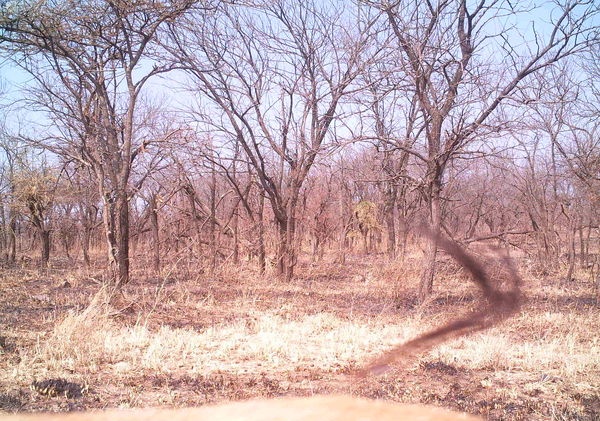

1
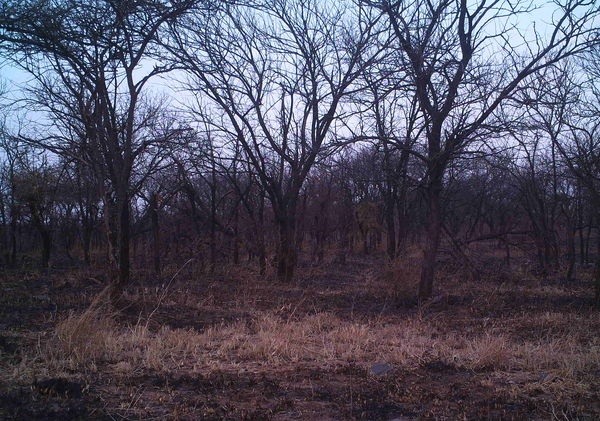
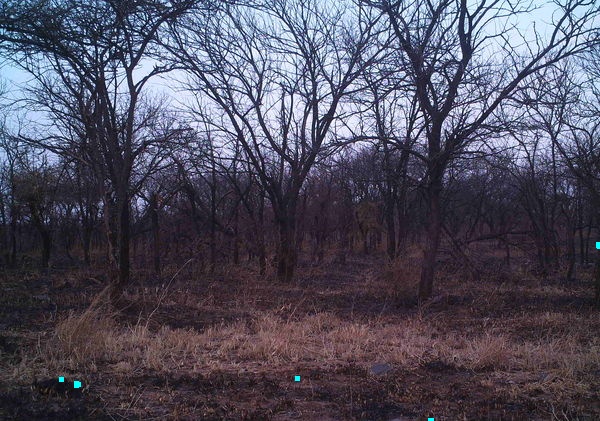
2

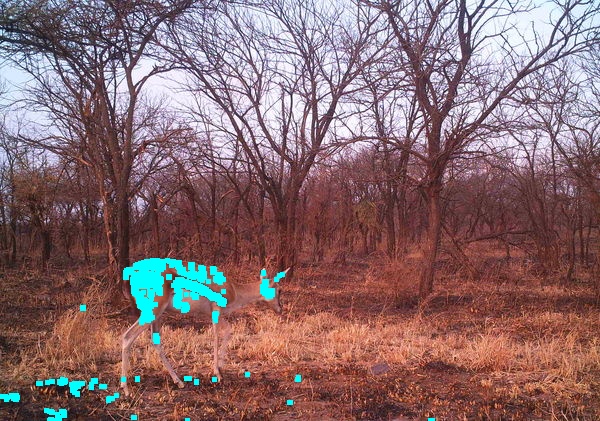
3
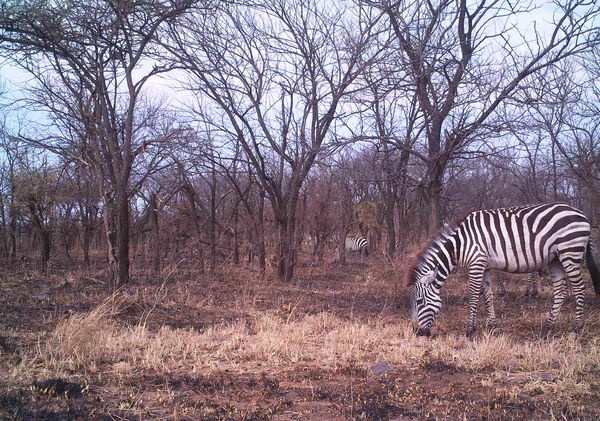
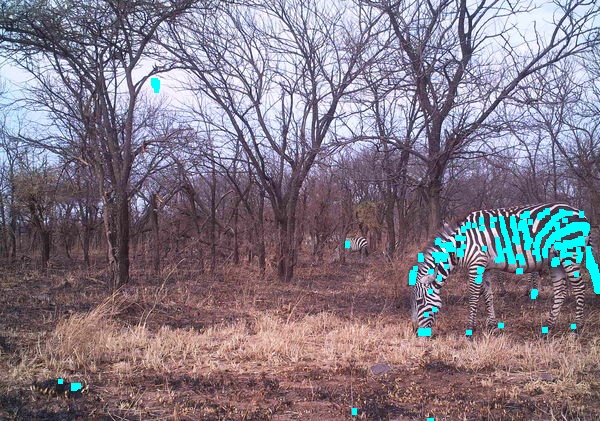
4
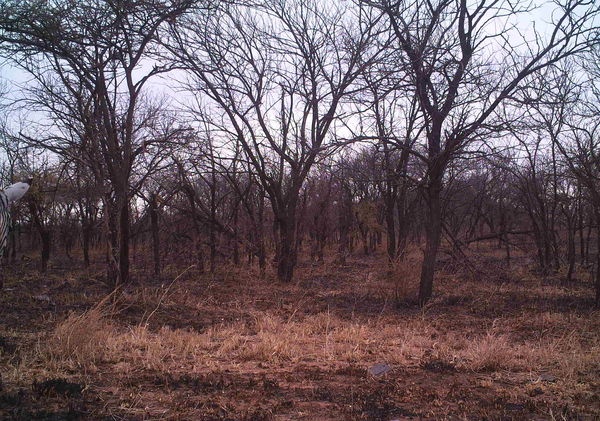
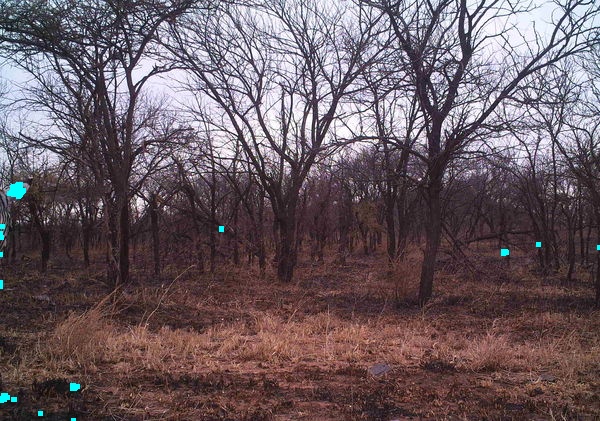
5

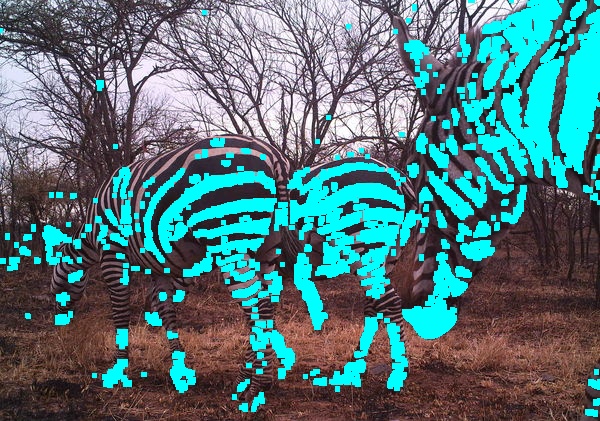
6


7
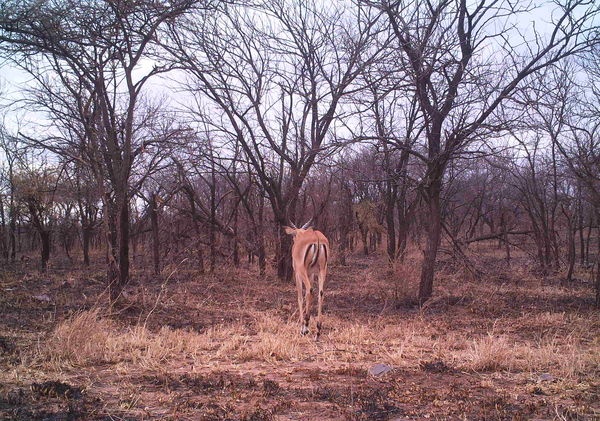

8
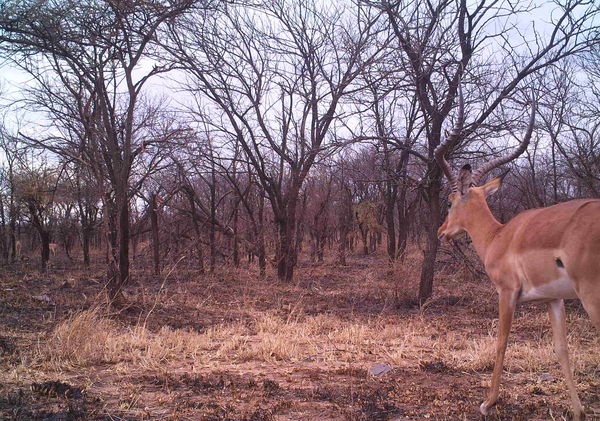
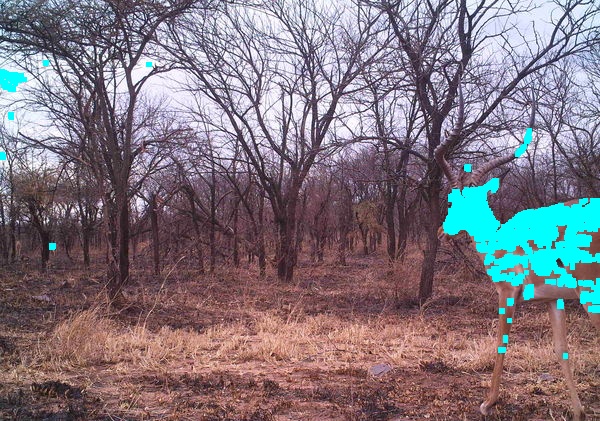
9
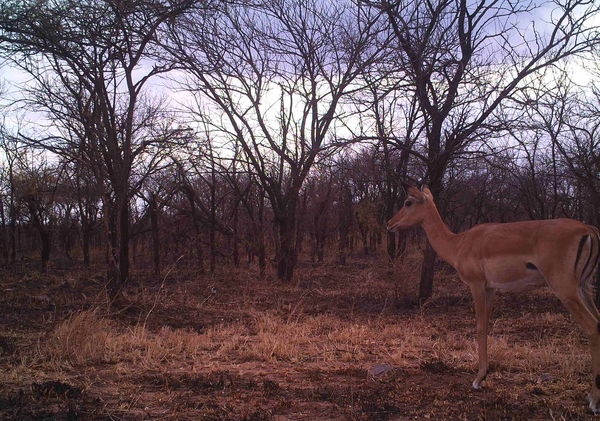
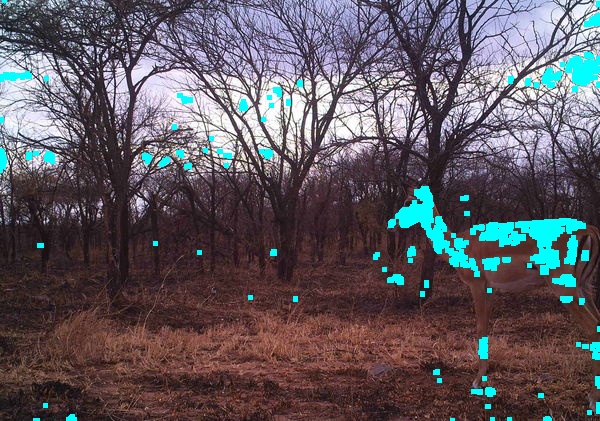
10
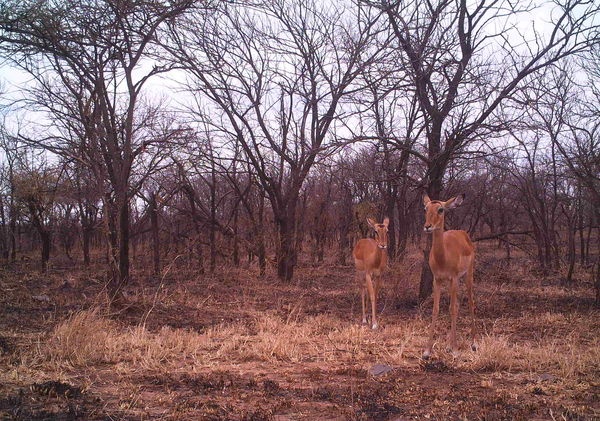
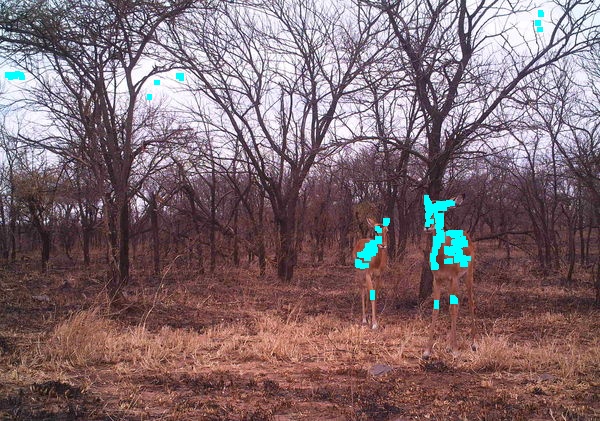
11


12
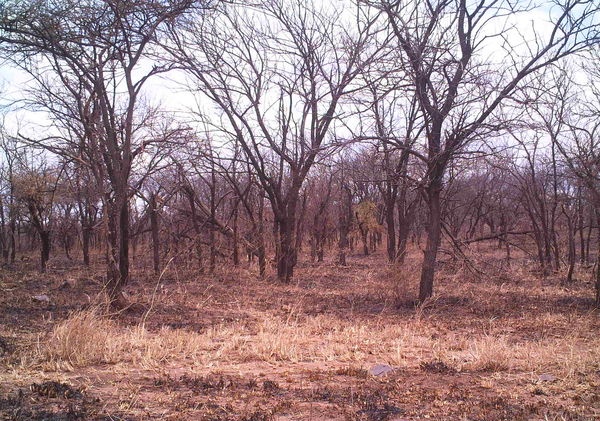
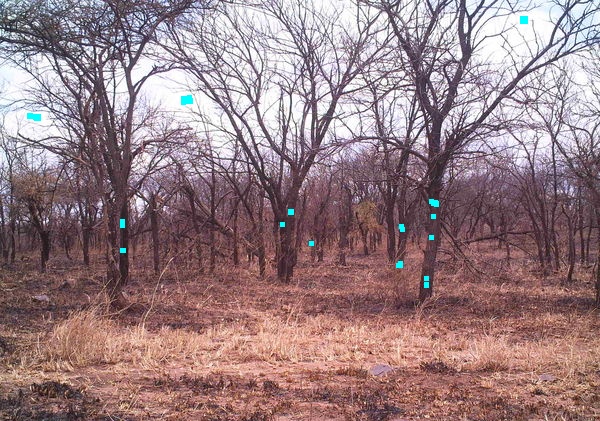
13
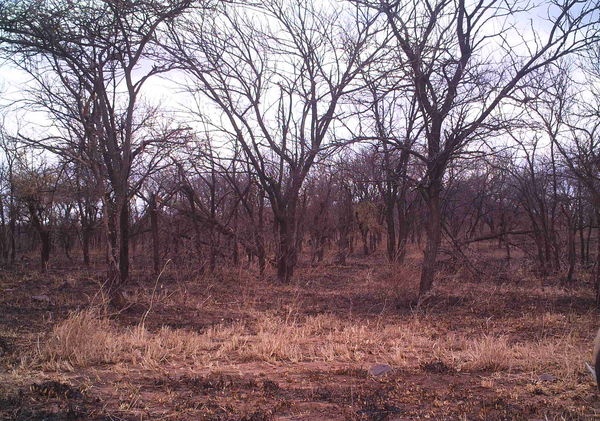
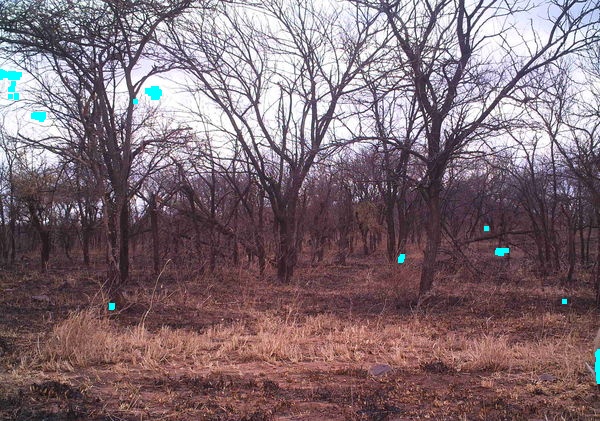
14

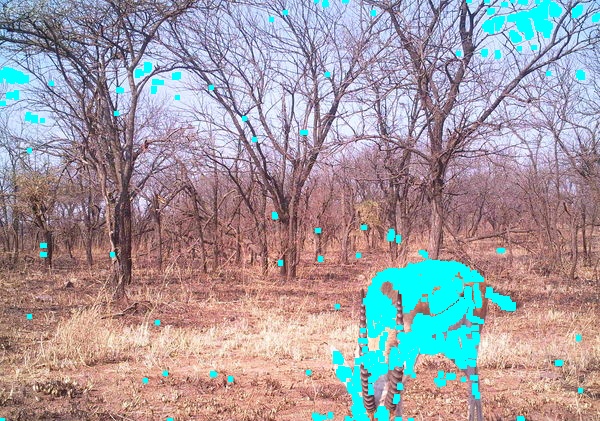
15

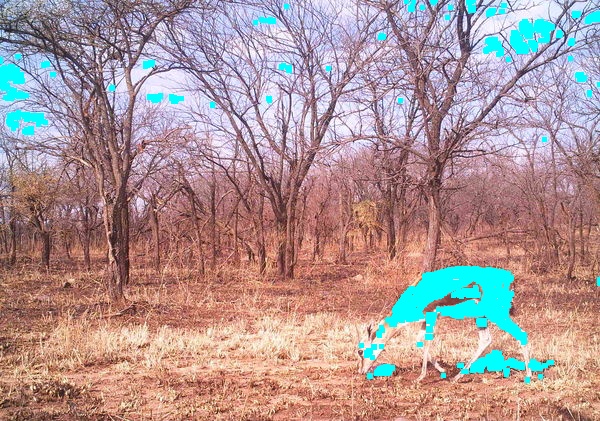
16


... Post continues below ...
A different approach to computer vision: Comparison to the average background

An example image of a gazelle

Detected animal using the background comparison technique
Zooniverse's outgoing Data Scientist Greg Hines wrote the following post about how we can use comparison to an average background to detect animals in camera trap images.
Detecting Blank Images
Suppose you have a series of images taken over a period of time from a fixed location. You want to know if there is something in each of those images. For example, you have a webcam set up that regularly takes a photo of a room - does anyone enter that room?
If you have a gold standard blank image and you know that the only thing that can change is someone entering the room - the solution is simple. If there is any difference between one of the images and the blank - someone is there. But what if other things can change? For example, lighting - there might be a window in the room. Or for something like Snapshot Serengeti we could be looking at a bunch of trees - the leaves could be blowing in the background. That's technically movement but not the kind we want.
Snapshot Serengeti provides timestamps and locations for all images so we can look at a time series of images. There is a tradeoff - the more images we have in our time series the accurate our calculations can be. But things change over time - grass, trees and leafs grow and die. So the time series probably wouldn't last months - probably more just days at most. We should also remove night time images - images where the average brightness is less than some certain threshold. We'll then read in the images ::
axis = 0
time_series = []
for fname in glob.glob("/home/ggdhines/Databases/images/time_series/*.jpg"):
img = cv2.imread(fname)[:,:,axis]
equ = cv2.equalizeHist(img)
f = equ.astype(float)
time_series.append(f)
axis = 0 means that we are only reading in the R values (out of the RGB values) - we could also read the images in grayscale. (Just experimenting with stuff). Equalizing the img (cv2.equalizeHist) (http://docs.opencv.org/3.1.0/d5/daf/tutorial_py_histogram_equalization.html#gsc.tab=0) helps to account for differences in lighting. We can look at the average image with :
mean_image = np.mean(time_series,axis=0)
plt.imshow(mean_image)

The calculated average background image
We can also calculate "percentile images" :
upper_bound = np.percentile(time_series,80,axis=0)
which gives us at each pixel the 80th percentile value. (i.e. 80 percent of the values at the pixel in our time series are less than or equal to this value). Similarly we can calculate the lower bounds :
lower_bound = np.percentile(time_series,20,axis=0)
Let's read in the image again and look for places where we have "extreme" pixels - pixels that lie below the 20th percentile or above the 80th ::
template = np.zeros(img.shape,np.uint8)
t2 = np.where(np.logical_or(equ>upper_bound , equ < lower_bound))
template[t2] = 255
Finally we apply an opening operation to remove isolated points (noise) - (http://docs.opencv.org/3.1.0/d9/d61/tutorial_py_morphological_ops.html#gsc.tab=0):
opening = cv2.morphologyEx(template, cv2.MORPH_OPEN, kernel)
The full code is at - https://github.com/zooniverse/aggregation/blob/master/time.py
Below are some examples - there are some false positives where a change in the sky is detected (we could filter out sky pixels) but false positives aren't bad. We see that animals are definitely detected. If we did DB scan we could look for clumps of "extreme" pixels - if there are none, we have a blank image.
This post was originally posted here. Please review the example images thatt follow, then add comments below and tell us what you think!
Examples
Here are some examples. In each case, the first image is the original captured photo, and the second one shows blue dots for the "detected change from background average".
0


1


2


3


4


5


6


7


8


9


10


11


12


13


14


15


16


... Post continues below ...
2 Participants
5 Comments
@Johnfairweather
The most interesting aspect (to me) of this paper titled “Recent Tectonic Activity on Pluto Driven by Phase Changes in the Ice Shell” is the extensional faults which indicate Pluto is expanding or growing. I’m calling them stretch marks as they seem to be occurring as the result of Pluto’s outer surface cracking due to its expansion or stretching. There are two methods a body like this could expand one is the premise put forth in the paper (a subsurface ocean is freezing and expanding), the other is by the addition of more material as in the case of impacts as put forth by me.
The paper says there is no evidence of compressive forces occurring recently, I think one must ignore the ridge line that runs from the North to South pole (especially at the southern area) to make this statement. This point is not that important to me and could be argued either way so I’ll leave it at that.
The issue of density is an important one.
Quote from Nick Stroble web page.
Terrestrial planets (Earth-like Mercury, Venus, Earth, Mars) have overall densities = 4-5 (relative to the density of water = 1) with silicate rocks on the surface. Silicate rock has density = 3 (less than the average density of a terrestrial planet) and iron has a density = 7.8 (more than the average density of a terrestrial planet). Since terrestrial planets have average densities greater than that for the silicate rocks on their surface, they must have denser material under the surface to make the overall average density what it is.
End Quote
Quote from the paper
Pluto is the largest object in the Kuiper Belt, with a radius R = 1187 km (Stern et al.
2015), and a bulk density of p = 1:86 ±0.013 g/cm3 (Stern et al. 2015), suggesting a mixed ice-rock composition (McKinnon et al. 1997, 2008).
End quote
The nitrogen fluid at Sputnik Planum is more dense than the ICEbergs which are floating atop the nitrogen hence the 1.86 density of Pluto could be due to the more dense nitrogen/methane mix along with a partially mixed silicate material not necessarily at its core but dispersed throughout Pluto unevenly suspended in frozen ice. Silicate rock has a density of 3 so if the core of Pluto was 70% silicate as suggested by Wikipedia and NASA, one would expect Pluto’s overall density to be greater than 1.847. Even at a density of 1.847 it doesn’t necessarily mean that Pluto is differentiated. It means there are materials in Pluto that are heavier than water one obvious material is nitrogen as can be seen by the water ice floating on its surface and even at a higher density than the ice mantle this visible nitrogen is seen flowing on Pluto's surface due to some form of subsurface pressure.
On Earth we assume there is a liquid iron core which has a density of 7.8 which is more than twice that of silicate rock yet there is iron on Earth’s rocky surface due to pressure released by volcanoes. If the fluid we see on the surface of Pluto is more dense than the ice mantle, doesn’t it stand to reason liquid nitrogen is being forced up from below and this is likely the fluid or ocean of material below Pluto’s surface. Nitrogen when frozen constricts unlike water which expands. So nitrogen in a fluid state expands but if it were freezing it would constrict yet we see evidence of Pluto’s surface stretching along with fluid nitrogen which is likely causing the stretching.
On Enceladus there is an ocean of water below the surface as it can be seen spewing out of its stretch marks on the surface. There is little evidence of water coming out of the stretch marks on Pluto but a great deal of evidence showing nitrogen flowing out of cracks but only specific cracks which are closest to the south pole and around SP. If this release of pressure was from a hot core why is the release of that pressure primarily focused to one area and not seen as more of a global phenomenon as can be seen throughout Earth with its core of iron magma?
Why is the nitrogen pressure release on Pluto primarily focused near or below the equator, along SP west edge (ridge line cryovolcanoes) and mostly East of SP (Wetlands, Desert Dunes, Spider)? My theory suggests impacts create this focused or localized release of pressure due to shock waves which then cool over time then start all over again with new impacts this is why Pluto has stretch marks as it grows from impacts rather than a solid differentiated core. Phonons are created by impact shock wave energy. Phonons play a major role in many of the physical properties of condensed matter, like thermal conductivity. Shorter-wavelength higher-frequency phonons give rise to heat.
In the paper, 8 to 10 assumptions have to be made in order to create this differentiated core model with a water ocean which is freezing and expanding. That’s a bit much for me. Any mathematical model can be created with enough assumptions and just because math can be used to support assumptions doesn’t make those assumptions correct. For me there are too many assumptions in this paper to convince me of its conclusion.
Something else that I struggle with regarding most scientific statements is how most of them assume all activities which created the planets and moons in our solar system all took place in the first 500 million years then everything seems to have stopped for 4 billion years. Our solar system is a continual process of change. From 1994 to 2013 (19 years) there have been 556 bolide impacts on Earth.
Neptune has created a pocket where objects coalesce in the Kuiper belt and are focused in a 3:2 resonant frequency. This forces Kuiper belt objects to cluster together and this is likely how Pluto was formed and is still being formed to this day. 90482 Orcus is one of the objects which Neptune swings into Pluto's orbit on a regular basis, 1994 JR1 is another and there are many more of these same type objects we know about and many we don't. These clustering of Kuiper belt objects and subsequent impacts is likely what causes Pluto/Charon to be frequently bombarded by objects which cause its growing pains and stretch marks from impacts and phonon shock waves.
@PolishPlanetPursuer model fits more closely to what I'm trying to express than the idea of a rocky core model with an ocean of water. I simply can't get past the cold temperatures out in the Kuiper belt. 40 degrees Kelvin is pretty cold and Pluto didn't just blow up to its current size instantly it took a lot of small, medium and large impacts to build it up gradually to what it is now and I think these impacts are still building it to this day. With this gradual growth, 40K temperatures would keep water ice rock hard with silicate trapped in suspension. This slow process of growth by impacts wouldn't give the silicate ample ability to separate out of the rock hard ice to any significant degree. The impact with Charon might have created an impressive amount of heat energy but enough to last 4 billion years on an object half the size of our moon? That's a pretty tough nut for me to swallow.
The paper suggest 5% ammonia mixed with water could have lowered its melt point to 250K. Then there would be the additional factor of pressure lowering the melt point further but the paper looses me with its complexity and assumptions at this point and does not specify a temperature which is reached due to pressure and other volatiles and salts mixed with the water. Furthermore, it is assumed there is ammonia in Pluto, it's not known none has been detected yet. However, ammonia is found on the surface of Charon but we don't know at what concentration levels and Charon appears to be frozen solid.
Good info and thanks for sharing, just not sold on it.
I can't get past the cold and the relative slow growth process.
If Pluto and Charon collided which seems to be a logical conclusion, why aren't their compositions similar?
Why isn't tholin developing naturally on Charon like it once did and still is on Pluto?
Where's the nitrogen and methane on Charon?
Where's the ammonia on Pluto? These question bug me and I may be getting a clue about some of it. Stay tuned there's more coming.
I've got to go turn the air conditioning up, I'm getting cold just talking about temperatures of 40K.
Pluto's heat source?
@Johnfairweather
The most interesting aspect (to me) of this paper titled “Recent Tectonic Activity on Pluto Driven by Phase Changes in the Ice Shell” is the extensional faults which indicate Pluto is expanding or growing. I’m calling them stretch marks as they seem to be occurring as the result of Pluto’s outer surface cracking due to its expansion or stretching. There are two methods a body like this could expand one is the premise put forth in the paper (a subsurface ocean is freezing and expanding), the other is by the addition of more material as in the case of impacts as put forth by me.
The paper says there is no evidence of compressive forces occurring recently, I think one must ignore the ridge line that runs from the North to South pole (especially at the southern area) to make this statement. This point is not that important to me and could be argued either way so I’ll leave it at that.
The issue of density is an important one.
Quote from Nick Stroble web page.
Terrestrial planets (Earth-like Mercury, Venus, Earth, Mars) have overall densities = 4-5 (relative to the density of water = 1) with silicate rocks on the surface. Silicate rock has density = 3 (less than the average density of a terrestrial planet) and iron has a density = 7.8 (more than the average density of a terrestrial planet). Since terrestrial planets have average densities greater than that for the silicate rocks on their surface, they must have denser material under the surface to make the overall average density what it is.
End Quote
Quote from the paper
Pluto is the largest object in the Kuiper Belt, with a radius R = 1187 km (Stern et al.
2015), and a bulk density of p = 1:86 ±0.013 g/cm3 (Stern et al. 2015), suggesting a mixed ice-rock composition (McKinnon et al. 1997, 2008).
End quote
The nitrogen fluid at Sputnik Planum is more dense than the ICEbergs which are floating atop the nitrogen hence the 1.86 density of Pluto could be due to the more dense nitrogen/methane mix along with a partially mixed silicate material not necessarily at its core but dispersed throughout Pluto unevenly suspended in frozen ice. Silicate rock has a density of 3 so if the core of Pluto was 70% silicate as suggested by Wikipedia and NASA, one would expect Pluto’s overall density to be greater than 1.847. Even at a density of 1.847 it doesn’t necessarily mean that Pluto is differentiated. It means there are materials in Pluto that are heavier than water one obvious material is nitrogen as can be seen by the water ice floating on its surface and even at a higher density than the ice mantle this visible nitrogen is seen flowing on Pluto's surface due to some form of subsurface pressure.
On Earth we assume there is a liquid iron core which has a density of 7.8 which is more than twice that of silicate rock yet there is iron on Earth’s rocky surface due to pressure released by volcanoes. If the fluid we see on the surface of Pluto is more dense than the ice mantle, doesn’t it stand to reason liquid nitrogen is being forced up from below and this is likely the fluid or ocean of material below Pluto’s surface. Nitrogen when frozen constricts unlike water which expands. So nitrogen in a fluid state expands but if it were freezing it would constrict yet we see evidence of Pluto’s surface stretching along with fluid nitrogen which is likely causing the stretching.
On Enceladus there is an ocean of water below the surface as it can be seen spewing out of its stretch marks on the surface. There is little evidence of water coming out of the stretch marks on Pluto but a great deal of evidence showing nitrogen flowing out of cracks but only specific cracks which are closest to the south pole and around SP. If this release of pressure was from a hot core why is the release of that pressure primarily focused to one area and not seen as more of a global phenomenon as can be seen throughout Earth with its core of iron magma?
Why is the nitrogen pressure release on Pluto primarily focused near or below the equator, along SP west edge (ridge line cryovolcanoes) and mostly East of SP (Wetlands, Desert Dunes, Spider)? My theory suggests impacts create this focused or localized release of pressure due to shock waves which then cool over time then start all over again with new impacts this is why Pluto has stretch marks as it grows from impacts rather than a solid differentiated core. Phonons are created by impact shock wave energy. Phonons play a major role in many of the physical properties of condensed matter, like thermal conductivity. Shorter-wavelength higher-frequency phonons give rise to heat.
In the paper, 8 to 10 assumptions have to be made in order to create this differentiated core model with a water ocean which is freezing and expanding. That’s a bit much for me. Any mathematical model can be created with enough assumptions and just because math can be used to support assumptions doesn’t make those assumptions correct. For me there are too many assumptions in this paper to convince me of its conclusion.
Something else that I struggle with regarding most scientific statements is how most of them assume all activities which created the planets and moons in our solar system all took place in the first 500 million years then everything seems to have stopped for 4 billion years. Our solar system is a continual process of change. From 1994 to 2013 (19 years) there have been 556 bolide impacts on Earth.
Neptune has created a pocket where objects coalesce in the Kuiper belt and are focused in a 3:2 resonant frequency. This forces Kuiper belt objects to cluster together and this is likely how Pluto was formed and is still being formed to this day. 90482 Orcus is one of the objects which Neptune swings into Pluto's orbit on a regular basis, 1994 JR1 is another and there are many more of these same type objects we know about and many we don't. These clustering of Kuiper belt objects and subsequent impacts is likely what causes Pluto/Charon to be frequently bombarded by objects which cause its growing pains and stretch marks from impacts and phonon shock waves.
@PolishPlanetPursuer model fits more closely to what I'm trying to express than the idea of a rocky core model with an ocean of water. I simply can't get past the cold temperatures out in the Kuiper belt. 40 degrees Kelvin is pretty cold and Pluto didn't just blow up to its current size instantly it took a lot of small, medium and large impacts to build it up gradually to what it is now and I think these impacts are still building it to this day. With this gradual growth, 40K temperatures would keep water ice rock hard with silicate trapped in suspension. This slow process of growth by impacts wouldn't give the silicate ample ability to separate out of the rock hard ice to any significant degree. The impact with Charon might have created an impressive amount of heat energy but enough to last 4 billion years on an object half the size of our moon? That's a pretty tough nut for me to swallow.
The paper suggest 5% ammonia mixed with water could have lowered its melt point to 250K. Then there would be the additional factor of pressure lowering the melt point further but the paper looses me with its complexity and assumptions at this point and does not specify a temperature which is reached due to pressure and other volatiles and salts mixed with the water. Furthermore, it is assumed there is ammonia in Pluto, it's not known none has been detected yet. However, ammonia is found on the surface of Charon but we don't know at what concentration levels and Charon appears to be frozen solid.
Good info and thanks for sharing, just not sold on it.
I can't get past the cold and the relative slow growth process.
If Pluto and Charon collided which seems to be a logical conclusion, why aren't their compositions similar?
Why isn't tholin developing naturally on Charon like it once did and still is on Pluto?
Where's the nitrogen and methane on Charon?
Where's the ammonia on Pluto? These question bug me and I may be getting a clue about some of it. Stay tuned there's more coming.
I've got to go turn the air conditioning up, I'm getting cold just talking about temperatures of 40K.
26 Participants
579 Comments
I know we just made dailyzoo, but I wanted to blow a trumpet for a magnificent piece of work by our OldWeather member propriome. Over our 6 years the volunteers on OW have spent many hours inspecting old maps and punctiliously discovering the modern name for places visited by the ships of Old Weather, currently dating back to 1844. Some places are in the farthest reaches of the Yellow River, and others in what is now the Russian Arctic, the list is enormous. So propriome has translated the Geographical Help boards into an amazing Atlas for us.
He comments: "I'd like to share a nice panoramic view of the actual extents of our Geographical Help Board... I won't be updating that table often, but it shows all 9789 places collected so far  https://goo.gl/oByvH9 "
https://goo.gl/oByvH9 "
It is a stunning piece of work that pays tribute to the intense support that citizen scientists can bring to their Zooniverse project. 
Daily Zoo Suggestions
I know we just made dailyzoo, but I wanted to blow a trumpet for a magnificent piece of work by our OldWeather member propriome. Over our 6 years the volunteers on OW have spent many hours inspecting old maps and punctiliously discovering the modern name for places visited by the ships of Old Weather, currently dating back to 1844. Some places are in the farthest reaches of the Yellow River, and others in what is now the Russian Arctic, the list is enormous. So propriome has translated the Geographical Help boards into an amazing Atlas for us.
He comments: "I'd like to share a nice panoramic view of the actual extents of our Geographical Help Board... I won't be updating that table often, but it shows all 9789 places collected so far  https://goo.gl/oByvH9 "
https://goo.gl/oByvH9 "
It is a stunning piece of work that pays tribute to the intense support that citizen scientists can bring to their Zooniverse project. 
56 Participants
223 Comments
I agree,
I think I need to reorient my brain back around Pluto.
There are those things that are pretty much concrete observational facts and then there are those things that are more speculative suggestive possibilities related to Pluto/Charon.
Some of the more concrete things are;
SP is a depression or a deep plane or Planitia.
SP is directly opposite Charon (not a coincidence).
Material IS welling up from below.
There is an atmosphere which snows down methane.
The methane travels from the north southward and accumulates on higher elevations.
SP is primarily a fluid of nitrogen that flows and is more dense than the water ice which floats in various sized blocks on its surface.
The size of ice blocks on the surface of SP are indicators of the depth of the fluid at those locations.
SP is shallow to the north and east while deep along the west and south
There are small cryovolcanoes lining the western edge on the land ice.
The western solid land ice heaves and bulges under subsurface pressures.
Charon has multiple large impacts on it's northern pole.
Charon's southern hemisphere (Vulcan Planitia) is smooth and collapsed like SP
Sulfur was detected on the surface of Charon but not Pluto.
SP and eastwards is very young as there are no impacts.
Gray fluid flows out of the eastern highlands into SP (this fluid likely rises as a fog off SP and condenses adiabatically out of the atmosphere as it encounters the highlands).
A wind appears to blow from the north pole to south.
Tholin blankets the entire visible planet and is covered over by methane snow and pasty fluid nitrogen.
A tholin band is most dominantly visible between 15 degrees north and 15 degrees south of the equator which never experiences arctic winter or summer (always sun lit).
Some of the more speculative concepts are;
There's an ocean of water below the surface of Pluto.
SP is an impact site.
There is sulfur below the surface mixed in with the theoretical ocean of water.
The core is differentiated, radio active, hot and still active.
Wright Mons is a cryovolcano.
Pluto and Charon collided.
Impacts cause planets to have tilted axis.
SP is the result of climatic conditions.
Charon's north pole impacts created the smooth surface on its southern hemisphere (my speculative theory).
SP smooth surface is the result of shards from Charon that impacted the opposite side (my theory).
There are quite a few speculative theories on the link you provide.
I will start reading more to see what pops up.
The moon Hyperion has got me thinking about Pluto's core and how it might be solid. As I find time I will create a page about it. I've seen some interesting things on Hyperion.

Pluto's heat source?
I agree,
I think I need to reorient my brain back around Pluto.
There are those things that are pretty much concrete observational facts and then there are those things that are more speculative suggestive possibilities related to Pluto/Charon.
Some of the more concrete things are;
SP is a depression or a deep plane or Planitia.
SP is directly opposite Charon (not a coincidence).
Material IS welling up from below.
There is an atmosphere which snows down methane.
The methane travels from the north southward and accumulates on higher elevations.
SP is primarily a fluid of nitrogen that flows and is more dense than the water ice which floats in various sized blocks on its surface.
The size of ice blocks on the surface of SP are indicators of the depth of the fluid at those locations.
SP is shallow to the north and east while deep along the west and south
There are small cryovolcanoes lining the western edge on the land ice.
The western solid land ice heaves and bulges under subsurface pressures.
Charon has multiple large impacts on it's northern pole.
Charon's southern hemisphere (Vulcan Planitia) is smooth and collapsed like SP
Sulfur was detected on the surface of Charon but not Pluto.
SP and eastwards is very young as there are no impacts.
Gray fluid flows out of the eastern highlands into SP (this fluid likely rises as a fog off SP and condenses adiabatically out of the atmosphere as it encounters the highlands).
A wind appears to blow from the north pole to south.
Tholin blankets the entire visible planet and is covered over by methane snow and pasty fluid nitrogen.
A tholin band is most dominantly visible between 15 degrees north and 15 degrees south of the equator which never experiences arctic winter or summer (always sun lit).
Some of the more speculative concepts are;
There's an ocean of water below the surface of Pluto.
SP is an impact site.
There is sulfur below the surface mixed in with the theoretical ocean of water.
The core is differentiated, radio active, hot and still active.
Wright Mons is a cryovolcano.
Pluto and Charon collided.
Impacts cause planets to have tilted axis.
SP is the result of climatic conditions.
Charon's north pole impacts created the smooth surface on its southern hemisphere (my speculative theory).
SP smooth surface is the result of shards from Charon that impacted the opposite side (my theory).
There are quite a few speculative theories on the link you provide.
I will start reading more to see what pops up.
The moon Hyperion has got me thinking about Pluto's core and how it might be solid. As I find time I will create a page about it. I've seen some interesting things on Hyperion.

26 Participants
579 Comments
I know what you mean, it bothers me when I hear about these animals suffering for people's mistakes. When plastic is in landfills it can be blown into the ocean or even if it's in the street the piece of plastic will make its way to the ocean if no one picks it up. One thing is recycling would definitely help keep some of these plastics from going to landfills just to then blow to the ocean and if the plastic is in a circle maybe cut that circle open so if a small fish or other animal got stuck in it, it could get out then.
Plastic, an argument
I know what you mean, it bothers me when I hear about these animals suffering for people's mistakes. When plastic is in landfills it can be blown into the ocean or even if it's in the street the piece of plastic will make its way to the ocean if no one picks it up. One thing is recycling would definitely help keep some of these plastics from going to landfills just to then blow to the ocean and if the plastic is in a circle maybe cut that circle open so if a small fish or other animal got stuck in it, it could get out then.
29 Participants
67 Comments